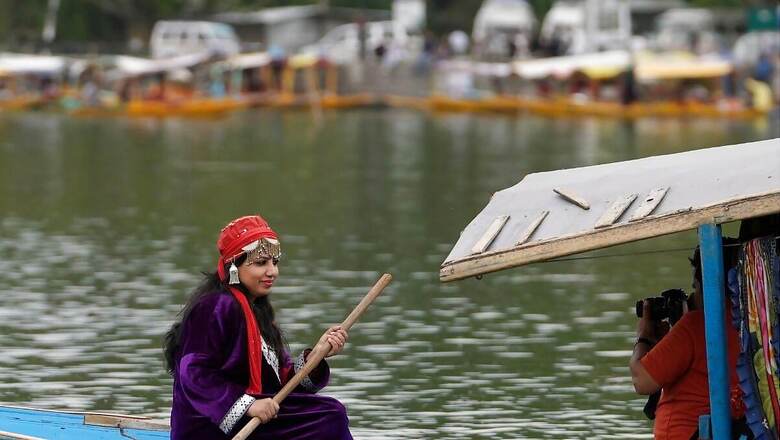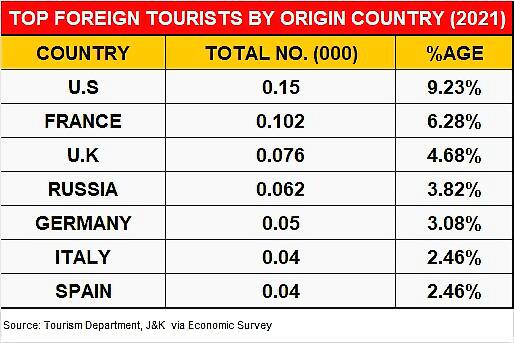
views
Four years after the abrogation of Article 370, tourism is booming in Jammu and Kashmir. With 1.27 crore tourists visiting the union territory up to July, India’s most picturesque region is poised to break last year’s record of 1.89 crore tourist arrivals.
According to data provided by the J&K administration, this year, more than 15,000 foreigners have visited up to June. This is significant, considering that only 4,028 foreign tourists arrived in J&K in the first half of 2022 with the overall number at 19,985.
Government sources said the total number of tourist arrivals in the UT is expected to cross two crore this year, a first for J&K that has long been caught amid cross-border terrorism. The Kashmir region also witnessed the highest-ever tourist arrivals last year with a record 27 lakh footfall, as per data from the UT’s tourism department. The previous highest arrival was recorded in 2016 when 13 lakh tourists visited the Valley.

In 2021, tourists from the US formed 9.23 percent of total foreigners, followed by France (6.28 percent), UK (4.68 percent) and Russia (3.82 percent), data shows.
Pilgrim’s progress
Spiritual tourism has also witnessed a massive upswing with over 58 lakh pilgrims visiting the famous Vaishno Devi shrine in Jammu region’s Reasi district till July, marking an increase of nearly three lakh in footfall as compared to the same period last year. In 2022, a total of 91.25 lakh pilgrims visited the shrine, which was the highest in nine years.
Besides, the ongoing Amarnath Yatra, too, has received a tremendous response with over 4 lakh pilgrims in the first 32 days, surpassing last year’s total figure of 3.66 lakh. The 62-day yatra to the Amarnath caves will end on August 31.
In his last ‘Mann Ki Baat’, Prime Minister Narendra Modi had mentioned two Americans, who were visiting from California for the Amarnath Yatra this year.
“These foreign guests had heard somewhere about the experiences of Swami Vivekananda related to Amarnath Yatra. They got so inspired that they came for it and consider it as the blessings of ‘Lord Bholenath’. This is the specialty of India that she accepts everyone, gives something or the other to everyone,” the prime minister had said.
The visit by foreigners to the holy shrine is also a reflection of their confidence in the improved security situation in the UT. The yatra had always been under a constant shadow of terror with multiple instances of attacks on pilgrims, most notably in 2000, 2001, 2002, 2006 and 2017.
‘Security has improved’
“The security situation has improved here and, as a result, peace has led to business in full flow. Areas like Sonmarg and Pahalgam are also witnessing a good tourism season,” said Ahmed, who runs the Zaffer Group of Houseboats in Srinagar.
Sajid Bhat, a taxi driver who earns his livelihood by taking tourists to different locations in the Valley, agreed. “At present, due to the ongoing Amarnath Yatra’s security measures, there is a slight dip in tourist footfall in Srinagar but this will pick up once the yatra is over and the autumn tourism season is here,” he said.
“Pehle se kaam abhi achha hai. On an average, I now get around 25 days of work every month as the situation has improved here. New hotels are coming up. Earlier, this was not the case,” he added, lamenting how he only gets two to three days of rest every month.
Bhat said: “We have no major industry here, and tourism is the mainstay of employment and the economy. Don’t trust what you hear from other sources,” adding, “come to Kashmir to see how helpful we are and to experience our mehman nawazi (hospitality).”
In full bloom
In addition to horticulture and agriculture, tourism plays a vital role in Jammu and Kashmir’s economy, contributing approximately 7 percent to its overall output. The good tourism season is also exposing Kashmir’s domestic industries to the world and helping them grow. Many people visiting the UT also visit local factories, and these visits often turn into big and small business opportunities.
“Tourists visit our factory to see how bats are made and some of them also purchase directly from us as it is cheaper to buy from here. This provides an excellent opportunity to exchange our views and showcase our domestic industry to the country and the world,” said Faizan Fayaz Dar, the manager at the Good Luck bat factory in Anantnag district, which claims to be making more than 500 bats per day and most of which are exported. Kashmir’s willow cricket bats are not just affordable but renowned for their powerful stroke play and toughness.
Given the sharp rise in tourist numbers, the UT administration of late is also encouraging homestays to accommodate more tourists and generate employment avenues.
Further, in a significant indicator of changed times, Srinagar’s tulip garden – the largest in Asia – had more than 3.7 lakh visitors this year: this is an all-time record. According to the state’s floriculture department data, the garden generated a revenue of Rs 2.49 crore in 2020-21, which rose by over 350 percent to Rs 11.27 crore during 2022-23 (ending February).
In May, the Centre hosted the G20 Tourism Working Group in Srinagar, marking the first major international gathering in Jammu and Kashmir since the abrogation of its special status in August 2019. Over three days, representatives from 27 countries were given the opportunity to visit the historic Mughal garden, enjoy a game of golf at Royal Springs Golf Course, and experience a shikara ride on Dal Lake.
Looking ahead
According to J&K Economic Survey 2022-23, the UT administration is developing 75 new tourist destinations, including heritage and cultural sites, Sufism/religious sites and adventure treks, covering all four seasons to boost the tourism sector. Focus areas include nature, adventure, pilgrimage, heritage and sports.
Additionally, they are exploring tourism in amusement parks, water parks and different adventure activities like water sports, rafting, rock climbing and snow parks to attract more tourists. In 2020, the J&K administration formulated a comprehensive tourism policy with several objectives, including generating employment for around 50,000 people annually and attracting an average investment of Rs 2,000 crore per year for the next five years.
Tourism and peace go hand in hand. When there is stability and tranquility, tourism will naturally flourish, providing a significant boost to J&K’s economy.















Comments
0 comment